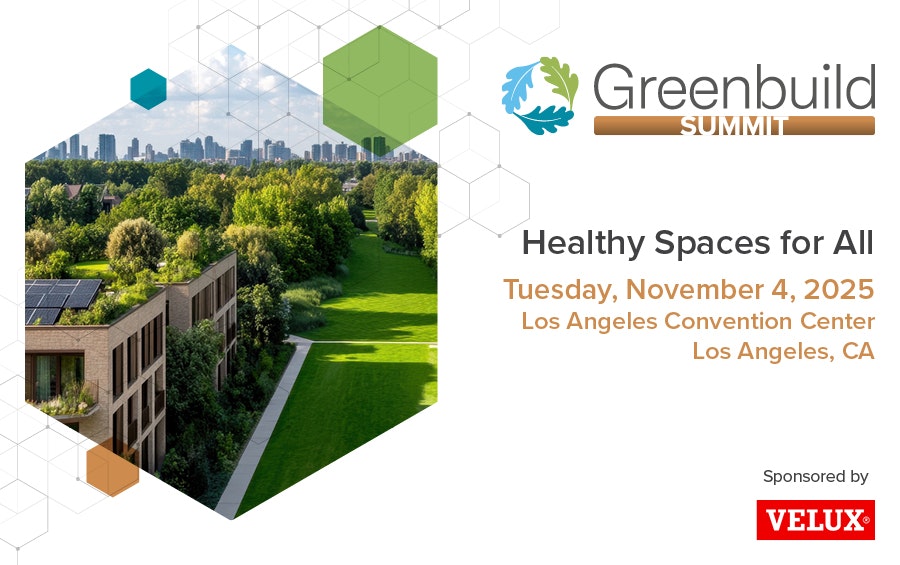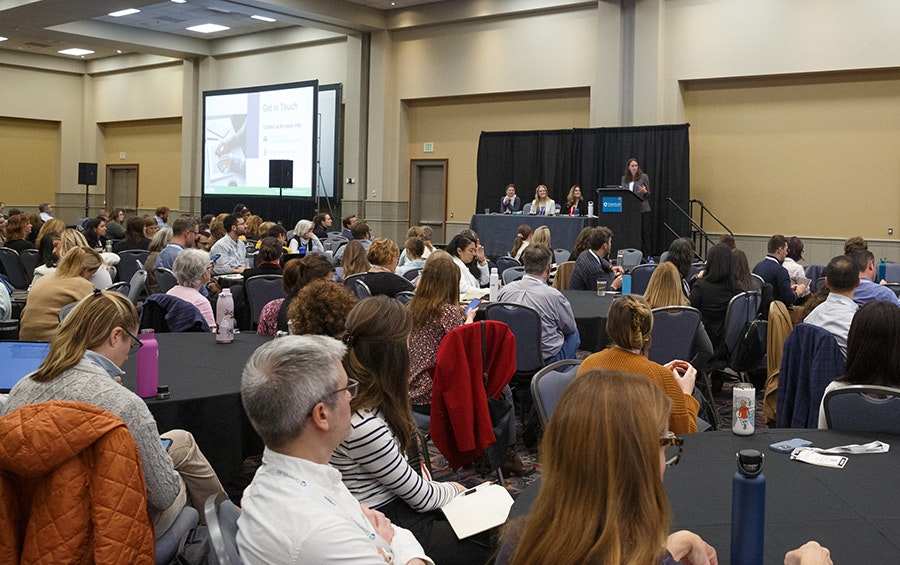Healthy Spaces for All Summit
A technical deep-dive into the impacts of the built environment on human health and adoption of strategies to enhance the wellbeing through building design.
Tuesday, November 4, 2025, at the Los Angeles Convention Center

Exploring Healthy Buildings Through Design
Awareness of the impacts of the built environment on human health and adoption of strategies to enhance the wellbeing of building occupants through design has grown since the green building movement was launched.
This Summit looks past occupants alone and considers the impacts of buildings on the health of supply chain workers, neighboring communities, and communities exposed to extraction, manufacturing, and disposal facilities; and looks past the average occupant to envision spaces that are safe and accessible for all.
What to Expect
CE-Accredited Sessions
Greenbuild's Summit Working Group has programmed an in-depth session to give attendees an inside look at how innovative building materials can help us solve and mitigate climate disasters. This all-day Summit will allow attendees to dive into use cases implementing healthy design principles, the benefits on occupant wellness, and how these strategies can benefit building projects.
Continuing education credits are available for Greenbuild's in-person summits.
Who Will You Hear From?
Our summit speakers bring their expertise, specialized knowledge and experience to the room for a focused learning experience like no other.
With CEOs, CIOs, Presidents, Vice Presidents, Partners and various other sustainability leaders taking to the stage, you couldn't be in better company.
Who Will You Meet?
Greenbuild features a cutting-edge community of global green building professionals looking to improve sustainability, resilience, equity, health and wellness in the spaces we live, work, play and learn. Take a look at who you'll meet at a Greenbuild summit.
Summit Sessions
Conceptual Foundations: The Built Environment and Public Health
The built environment profoundly shapes health outcomes across multiple scales—from individual occupants to neighboring communities and global supply chains. The public health impacts of the built environment are not uniform across populations, with climate change and toxic chemical exposures creating disproportionate burdens on marginalized communities. This opening session establishes how building performance intersects with these public health and climate challenges, setting the stage for the Summit's exploration of actionable strategies throughout the project delivery cycle.
Built environment practitioners can proactively promote health using integrative approaches that incorporate community input, public health data, and collaboration across diverse stakeholder groups. The panel will explore the concept of "healthy spaces for all," examining how real estate, design, engineering, and construction decisions impact health and well-being. Panelists will discuss how building performance ripples outward, from the project boundaries to impacts on local community health as well as across the full project lifecycle and supply chain.
An increasing body of financial research demonstrates compelling return-on-investment (ROI) for health-focused building strategies, making it easier to advocate for a people-centric approach. The panel will establish this case that links human and financial outcomes, equipping practitioners with ROI messages needed to engage diverse decision makers—from investors and developers to facility managers and community leaders.
The panel will close with an interactive workshop allowing participants to apply these concepts and connect with fellow attendees. This hands-on exercise demonstrates how to utilize an integrative process that leverages tools from both LEED and WELL to assess a project's environmental and public health context, engage key stakeholders, establish explicit health goals, implement targeted strategies, and plan for ongoing impact monitoring.
Learning level: introductory
Learning objectives:
Upon completion, participants will understand how building performance impacts health outcomes across multiple scales—from individual occupants to neighboring communities and global supply chains.
Upon completion, participants will recognize the financial case for health-focused building strategies and be equipped with ROI messages to engage diverse decision makers.
Upon completion, participants will have applied an integrative process that leverages tools from both LEED and WELL to establish explicit health goals for building projects.
Upon completion, participants will identify opportunities to promote health throughout the project delivery cycle, from planning and design through development and operations.
Applications Part 1: Beyond the Typical Occupant: Designing for all
We are familiar with general design strategies for healthy, comfortable, and productive spaces, but do they work well for people with a range of ages, abilities, and circumstances? How does designing for the widest range of people create better design and benefit everyone?
This session examines how the built environment can support health, equity, satisfaction, and a sense of belonging through various design approaches such as healing-centered design, inclusive design, and biophilic design. We will discuss the range of impacts that buildings can have on occupants, from reducing discomfort to promoting positive experiences. The panel will cover different design approaches and present case studies of successful projects where innovative strategies were implemented through an integrative process. Together, these practices form comprehensive, human-centered approaches to planning, designing, and operating buildings that prioritize health, inclusivity, and overall well-being of all occupants.
Learning Level: Intermediate
Learning Objectives:
- Describe important considerations in designing inclusive spaces that promote health outcomes
- Name example strategies for inclusive, trauma-informed, and biophilic design
- Outline integrated design process that promotes the collaboration of various disciplines in developing inclusive space for all occupants
Applications Part 2: Co-designing community health and wellbeing
As the green building movement matures, we recognize our work is within existing communities, and there is an opportunity to work together to advance occupant and public health. This session will explore how buildings shape community health through their design, construction, and operation, focusing on tangible applications.
Through a series of case studies, experienced practitioners will share innovative approaches to achieving a strong, two-way relationship between a developments and its surrounding environment: Whereby community input and regional data on climate, health, and population conditions inform design priorities; and a development generates ongoing social, economic, and public health value for the community it is based in. Opportunities, challenges, and practical strategies for stakeholders ranging from investors and developers to architects, facilities operators, and community groups, will be discussed. Examples include: Relocation strategies to combat displacement, creation of publicly accessible spaces and bike paths, measures to preserve biodiversity, specification of materials that are less toxic when exposed to fires or extreme heat, and health impact assessments.
Attendees will leave with frameworks for action, an understanding of the value of co-design with community members, and inspiration for shaping their practices to turn buildings into agents of community health improvement.
Learning Level: Intermediate
Learning Objectives
- Understand the broader public health implications of green building practices on local communities.
- Analyze case studies that demonstrate effective community health outcomes.
- Identify methods for engaging and co-designing with communities.
- Apply data-driven frameworks to plan for and assess health impacts.
Applications Part 3: Buildings’ Life Cycle and Global Health Impacts
The health impacts of buildings reach far beyond their walls and even beyond the local community, but we rarely think about how the material and energy flows through our buildings impact human and environmental health across the globe. The selection of materials is often divorced from an understanding of where they come from, where they end up after use and then pollution, chemical exposure, or working conditions that impact health throughout their life cycle. The materials used to construct our buildings can impact the health of workers and fenceline communities during extraction; manufacturing; transportation; installation; and recycling or disposal. Building materials also have global impacts on all of our health through chemical and microplastic pollution. In addition, fossil fuels and the pollution they cause, from both their use to power our buildings and to make building products are undermining public and planetary health.
The good news? Innovative industry leaders are broadly defining “healthy spaces” to incorporate global considerations of whose health is impacted by our building, inclusive of the life cycle chemical, climate, and justice impacts of materials. In this session, hear concrete examples from industry experts who are taking action. Learn how they are tackling these complex issues on specific projects and beyond and hear about tools and approaches you can use to take action and create spaces that are just and healthier for all.
Learning Level: Intermediate
Learning Objectives:
- Understand the life cycle and global health impacts of buildings.
- Identify tools and practices to tackle health impacts of building products across their life cycle.
- Cite example solutions to account for and reduce the global impacts of a building project
Secure Your Spot
Greenbuild's Summits offer a technical, hands-on course where you can work directly with experts and peers on critical topics impacting our industry.
Summits included in Conference and Student Passes
Summit Working Group Members
The Greenbuild Summit Working Group consists of green building experts that advises our conference and program team on all aspects of our 2025 Summits, ensuring Greenbuild is at the forefront of the industry.
- Seema Bhangar, Principal, Healthy Buildings and Communities, U.S. Green Building Council
- Kelly Worden, Vice President, ESG and Social Sustainability, IWBI
- Rebecca Stamm, Senior Researcher, Habitable
- Sahar Abbaszadeh, Associate & Senior Consultant, Arup
- Erin Christensen Ishizaki, Partner, Mithun
Summit Sponsorship Available
Guarantee that the green building industry identifies you as a partner by sponsoring one of Greenbuild's Summits or Workshops taking place Tuesday, November 4, 2025, at the Los Angeles Convention Center.
Eric Peterson
Sponsorship Opportunities
202.256.0939
eric.peterson@informa.com



